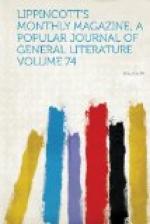as a general rule, the enjoyment of landscapes precedes
that of figures, and expression strikes us sooner
than form, while color comes last of all; but this
differs with different temperaments. I suppose
there are few who do not feel a little stupid amusement
at first at inaccuracies of costume and accessories
in the older pictures, but we soon become as indifferent
to them as the painters were themselves. One grows
so accustomed to see scriptural personages presented
in the dress and surrounded by the architecture or
landscape of Southern Europe of three centuries ago
that the anachronism or inconsistency ceases to strike
one. Perhaps it is because armor and flowing robes,
colonnades and branching trees, never seem out of
keeping with events of a certain dignity. I am
not sure that the traveler ever becomes quite unconscious
of the incongruity of the old Flemish dress and decorations,
in most cases strongly enhanced by the prim composure
which is the elementary expression of the earlier Netherlandish
faces: this is still discernible through all
transitory emotions of fear, hate, love or anguish,
and does not fail to produce very tragi-comic combinations.
I remember a group of a man in the dress of an Antwerp
burgher sitting on a three-legged stool, with his head
on the knee of a discreet-looking woman in a long-waisted,
plain-skirted gown, with a high square bodice closed
by a plaited neckerchief, her hair drawn tightly back
under a close round cap, her pocket hanging from her
girdle on one side, and on the other a small array
of housewifery implements, among others a pair of
scissors, with which she is clipping his locks:
her expression is so placid and thrifty withal that
it seemed clear she was saving a penny for her goodman
instead of sending him to the barber. But this
was not the painter’s idea: the two were
Samson and Delilah. Better than this was a painting
of Susannah and the elders, where the chaste Susannah
is depicted clothed to the throat like a Dutch burgomaster’s
wife, with a close cap and long veil, while her perilous
ablutions are typified by a small wash-basin on the
ground beside her. Another almost as grotesque
was a Massacre of the Innocents by Peter Breughel
the Elder—a snow-scene in the wide street
of a red brick, high-gabled village—soldiers,
parents, children, all in the stiff, ungraceful Flemish
dress of the sixteenth century, the poor little children,
in square trousers and pinafores, clinging to their
mothers’ narrow skirts. Oddly enough, it
made the story more real to me than it had ever seemed
before, quite painfully and terribly so, indeed:
dispoiled of its usual conventional character, it
became definite, and the very historical inaccuracy
which destroyed the traditional conception made it
an historical fact. We have only to go to Ghent
and Bruges to see how the genius and devout earnestness
of the Van Eycks, Van der Heyden and Hemling raise
their pictures above trifling absurdities. It
is undeniable that with many of us the constant presentation




